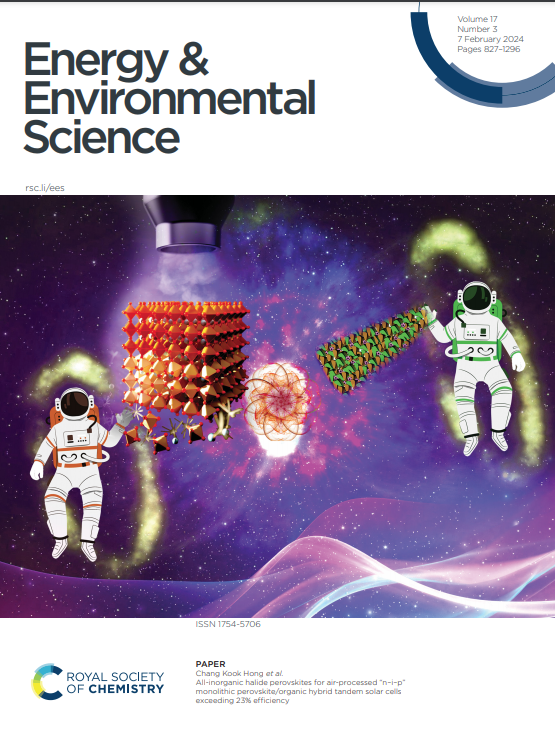Nanofluidic-enhanced high-mass-loading electrodes for energy-dense and high-rate lithium-sulfur batteries
IF 30.8
1区 材料科学
Q1 CHEMISTRY, MULTIDISCIPLINARY
引用次数: 0
Abstract
High-mass-loading sulfur cathodes with high areal capacity are critical for developing energy-dense lithium-sulfur (Li-S) batteries. However, facilitating efficient Li+ ion and electron transport in high-mass-loading sulfur electrodes remains a great challenge due to the extended pathways and inferior ion-electron transfer, especially at a high charge/discharge rate. To address the issue, we develop an ion-gated coating layer inspired by the nanofluidic effects in organisms (IGCL-NFE), which enhances the Li+ diffusion coefficient (D) and transference number (µ+) to enable ultrafast and selective Li+ transport in thick sulfur electrodes. The IGCL-NFE exhibits a characteristic biomimetic nanofluidic ion transport behavior, yielding a high µ+ (~2.1 times higher than that in the bulk solution) and a high D (~1012 times higher than that in the bulk solution) at a low Li salt concentration of 10-6 mol L-1. With selective and fast Li+ conduction, coupled with the high electrical conductivity of the IGCL-NFE, the IGCL-NFE-enhanced sulfur cathode demonstrates exceptional rate performance (757.8 mAh g-¹ after 300 cycles) at a high rate of 10.0 C. As a proof of concept, Li-S batteries utilizing the dry electrode with an ultrahigh sulfur loading of 18.7 mg cm-2 achieve an impressive energy density of 430.6 Wh kg-1. Furthermore, the Li-S full cell exhibits stable cycling performance over 100 cycles, retaining a high capacity of 1313.9 mAh g-¹ even at -20 °C. The nature-inspired, nanofluidic-enhanced electrode design presents a promising strategy for developing ultrahigh-mass-loading and high-rate Li-S batteries.用于能量密集和高倍率锂硫电池的纳米流体增强高质量负载电极
具有高面积容量的高质量负载硫阴极是开发高能量锂硫电池的关键。然而,在高质量负载的硫电极中,由于路径延长和离子-电子转移较差,特别是在高充放电速率下,促进高效的Li+离子和电子传输仍然是一个巨大的挑战。为了解决这个问题,我们开发了一种受生物纳米流体效应启发的离子门控涂层(IGCL-NFE),它可以增强Li+的扩散系数(D)和转移数(µ+),从而实现Li+在厚硫电极中的超快速和选择性传输。在10-6 mol L-1的低Li盐浓度下,IGCL-NFE表现出典型的仿生纳米流体离子传输行为,产生高µ+(比本体溶液高2.1倍)和高D(比本体溶液高1012倍)。由于具有选择性和快速的Li+传导,加上IGCL-NFE的高导电性,IGCL-NFE增强硫阴极在10.0 c的高倍率下表现出卓越的倍率性能(300次循环后757.8 mAh g-¹)。作为概念证明,使用具有18.7 mg cm-2的超高硫负荷的干电极的Li- s电池实现了令人印象印象的430.6 Wh kg-1的能量密度。此外,锂- s电池在100次循环中表现出稳定的循环性能,即使在-20°C下也能保持1313.9 mAh g-¹的高容量。这种受自然启发的纳米流体增强电极设计为开发超高质量负载和高倍率锂电池提供了一种有前途的策略。
本文章由计算机程序翻译,如有差异,请以英文原文为准。
求助全文
约1分钟内获得全文
求助全文
来源期刊

Energy & Environmental Science
化学-工程:化工
CiteScore
50.50
自引率
2.20%
发文量
349
审稿时长
2.2 months
期刊介绍:
Energy & Environmental Science, a peer-reviewed scientific journal, publishes original research and review articles covering interdisciplinary topics in the (bio)chemical and (bio)physical sciences, as well as chemical engineering disciplines. Published monthly by the Royal Society of Chemistry (RSC), a not-for-profit publisher, Energy & Environmental Science is recognized as a leading journal. It boasts an impressive impact factor of 8.500 as of 2009, ranking 8th among 140 journals in the category "Chemistry, Multidisciplinary," second among 71 journals in "Energy & Fuels," second among 128 journals in "Engineering, Chemical," and first among 181 scientific journals in "Environmental Sciences."
Energy & Environmental Science publishes various types of articles, including Research Papers (original scientific work), Review Articles, Perspectives, and Minireviews (feature review-type articles of broad interest), Communications (original scientific work of an urgent nature), Opinions (personal, often speculative viewpoints or hypotheses on current topics), and Analysis Articles (in-depth examination of energy-related issues).
 求助内容:
求助内容: 应助结果提醒方式:
应助结果提醒方式:


